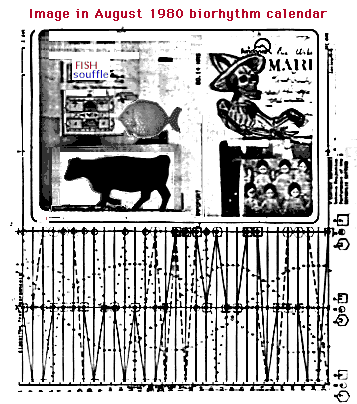

Biorhythm is an interactive installation in which participants are
asked
to evaluate how they feel and to compare their feelings with a computer
analysis of their biorhthym condition for that day. Then a palmist
reading
of their thumbs reveals another aspect of that question - juxtaposing a
technologically based analysis with a psychologically derived one. The
installation
elements in the exhibit at WORKS Gallery in San Jose, California, 1983,
consist of one year of twelve large calendars upon which Rapoport
collaged
each day's important events. At the same time that she created this
pictorial
diary she charted her estimate of her own biorhythm condition. After a
year
of recording this data, she compared her evaluation with a computer
anaysis
of her biorhythm cycles. Shown beside each calendar month is a printout
of this analysis. The wall exhibit culminates in a trio of superimposed
36" vellum plots that expose the union of commonalities of her
biorhythm
evaluation and the computer's prediction.
The interactive part of the installation starts when the participants
declare
"how they feel"at the front desk where they receive a hospital
wristband of the appropriate color. They are seated in a chair, don a
dentist's
bib and are photographed expressing their feelings with their hands
poised
in front of the bib. The participants are also asked to speak this
condition
into a microphone to be recorded. Their own biorythm evaluation is
compared
with biorhythm analyses on the three computers at the site. If the
evaluation
and the analysis are the same the participants are declared winners and
receive a blue ribbon. Recording on a chart the comparative results of
the
biorhythm data and the palmist reading finalizes the participation
performance.
Elements from the Biorhythm installation were exhibited with the
audio recordings at the Clock Tower, New York City; the Art Commission
gallery,
San Francisco; and the Otis Institute of the Parson's School of Design,
Los Angeles, California, from 1984 to 1985.
A video of the event was made with Skip Sweeny. It was shown at the
University
Film Archive, Berkeley and New Langton Arts, San Francisco, 1984.